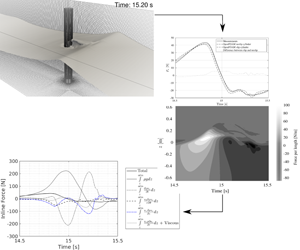Article contents
Detailed force modelling of the secondary load cycle
Published online by Cambridge University Press: 21 February 2020
Abstract

Steep wave passage around vertical circular cylinders is associated with an additional force peak occurring after the main peak: the secondary load cycle. The secondary load cycle for a focused wave group typical of offshore wind turbine foundations at 33 m full-scale water depth is investigated in scale 1 : 50. Ensemble-averaged force, front face pressures and free surface elevation measurements are used as the basis for the investigation. A two-phase free-surface Reynolds-averaged Navier–Stokes solver is validated against generic cases of turbulent flow over a wall, wave-boundary layer flow for a Reynolds number,  $Re$, of
$Re$, of  $1\times 10^{4}<Re<1\times 10^{7}$, two-dimensional (2-D) drag on a cylinder for
$1\times 10^{4}<Re<1\times 10^{7}$, two-dimensional (2-D) drag on a cylinder for  $1\times 10^{2}<Re<2.5\times 10^{5}$ and 2-D oscillatory flow for three combinations of
$1\times 10^{2}<Re<2.5\times 10^{5}$ and 2-D oscillatory flow for three combinations of  $Re=\{5.8\times 10^{4},9\times 10^{4},1.7\times 10^{5}\}$ and Keulegan–Carpenter number,
$Re=\{5.8\times 10^{4},9\times 10^{4},1.7\times 10^{5}\}$ and Keulegan–Carpenter number,  $KC=\{6,12,18\}$, respectively. The solver is next applied to reproduce ensemble-averaged experimental results of the focused wave group and a good match for the inline force and free surface elevation is found along with a good match for the measured front face pressures. The numerical solution for the focused wave is next analysed in detail to explain the cause of the secondary load cycle. We find that the secondary load cycle is confined to an upper region ranging from just above the still water level to 1.5 cylinder diameters below. By a further break down of the pressure field into contributions from the individual terms of the vertical Navier–Stokes equation, we find that the local force peak in the secondary load cycle is mainly caused by suction effects around the still water level on the back side, contributed through the material time derivative of the vertical velocity,
$KC=\{6,12,18\}$, respectively. The solver is next applied to reproduce ensemble-averaged experimental results of the focused wave group and a good match for the inline force and free surface elevation is found along with a good match for the measured front face pressures. The numerical solution for the focused wave is next analysed in detail to explain the cause of the secondary load cycle. We find that the secondary load cycle is confined to an upper region ranging from just above the still water level to 1.5 cylinder diameters below. By a further break down of the pressure field into contributions from the individual terms of the vertical Navier–Stokes equation, we find that the local force peak in the secondary load cycle is mainly caused by suction effects around the still water level on the back side, contributed through the material time derivative of the vertical velocity,  $\text{D}\unicode[STIX]{x1D70C}u_{z}/\text{D}t$. The suction occurs due to the rapid decrease of water level below the generated water column at the back of the cylinder, which at this time has only just begun its downward motion. The first force local minimum in the secondary load cycle is aided by the hydrostatic pressure from the water column while the second local minimum of the secondary load cycle is aided by wash-down effects on the front side. Finally, the role of the observed vortices behind the cylinder is discussed and compared to reference computations with slip conditions. The results confirm findings from earlier slip boundary studies that the global force history through the secondary load cycle is not strongly affected by the boundary layer. The source of vortices behind the cylinder, observed in both sets of computations is discussed.
$\text{D}\unicode[STIX]{x1D70C}u_{z}/\text{D}t$. The suction occurs due to the rapid decrease of water level below the generated water column at the back of the cylinder, which at this time has only just begun its downward motion. The first force local minimum in the secondary load cycle is aided by the hydrostatic pressure from the water column while the second local minimum of the secondary load cycle is aided by wash-down effects on the front side. Finally, the role of the observed vortices behind the cylinder is discussed and compared to reference computations with slip conditions. The results confirm findings from earlier slip boundary studies that the global force history through the secondary load cycle is not strongly affected by the boundary layer. The source of vortices behind the cylinder, observed in both sets of computations is discussed.
- Type
- JFM Papers
- Information
- Copyright
- © The Author(s), 2020. Published by Cambridge University Press
References
- 17
- Cited by


